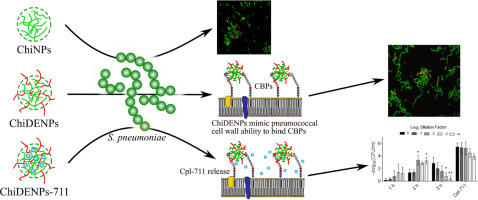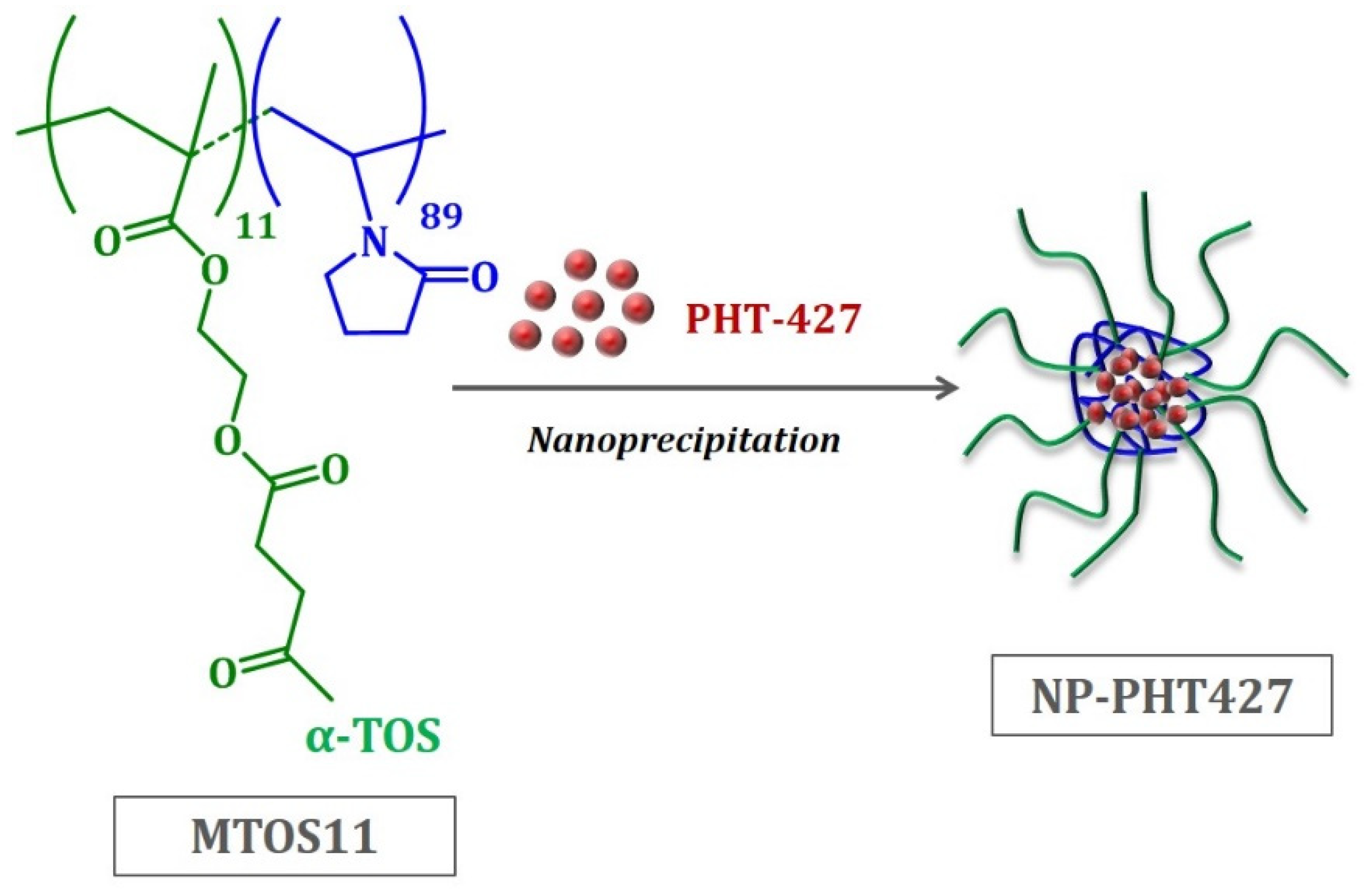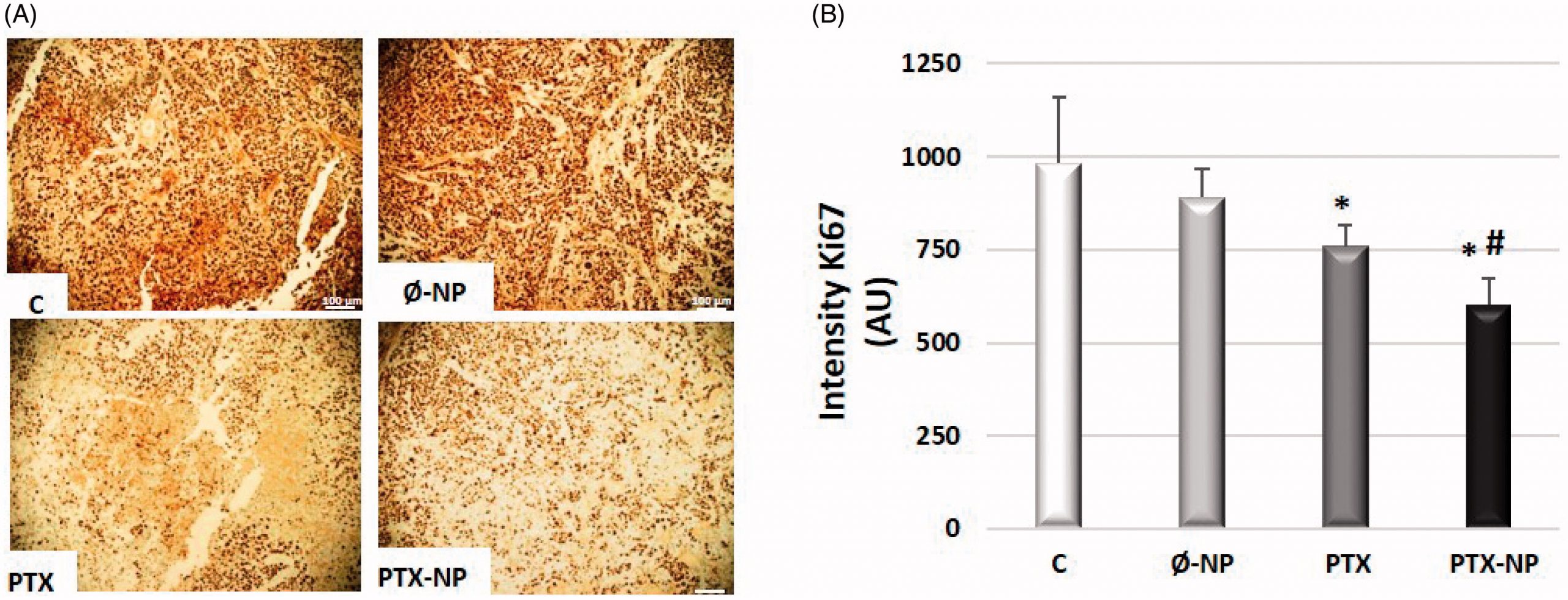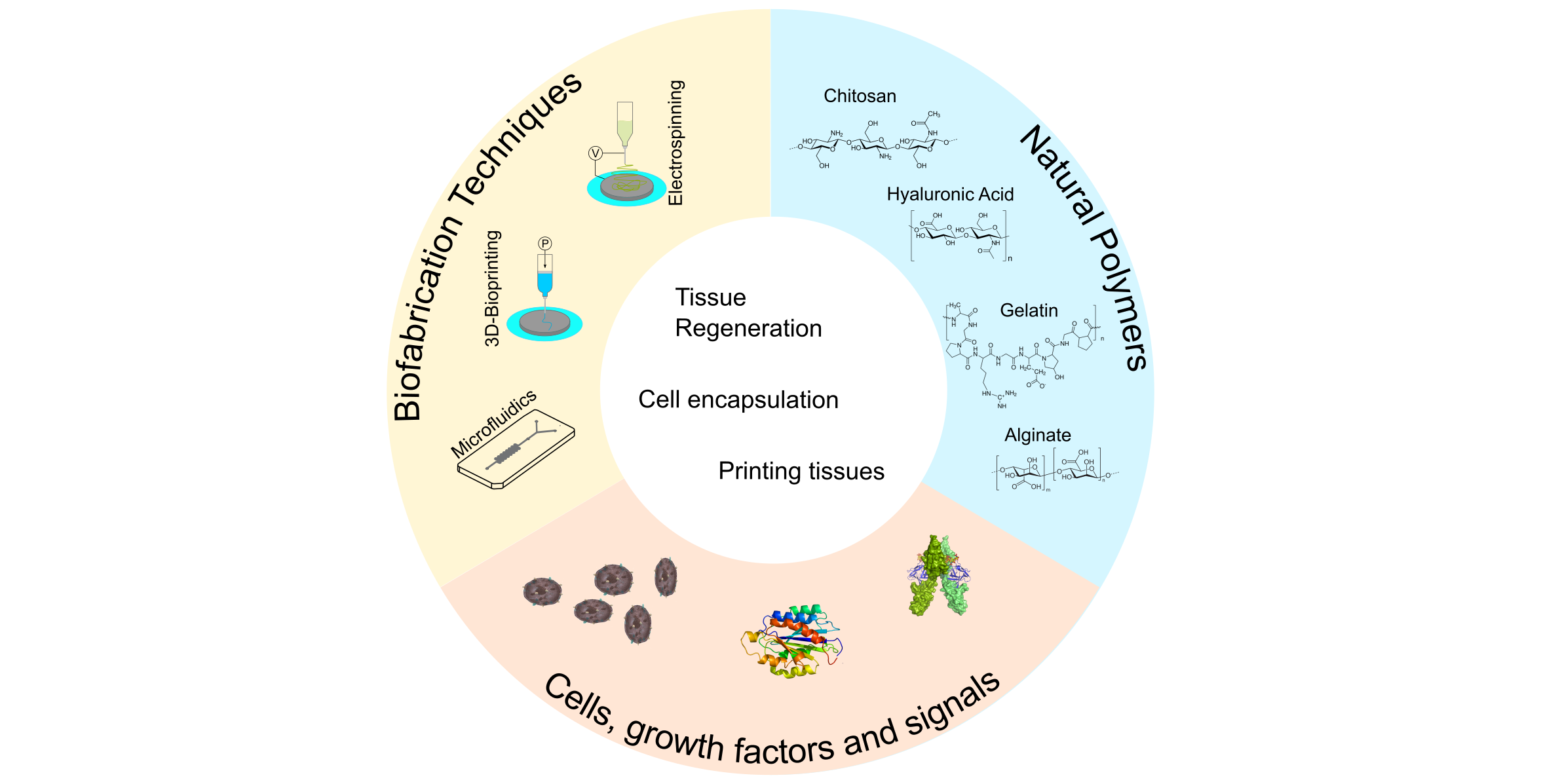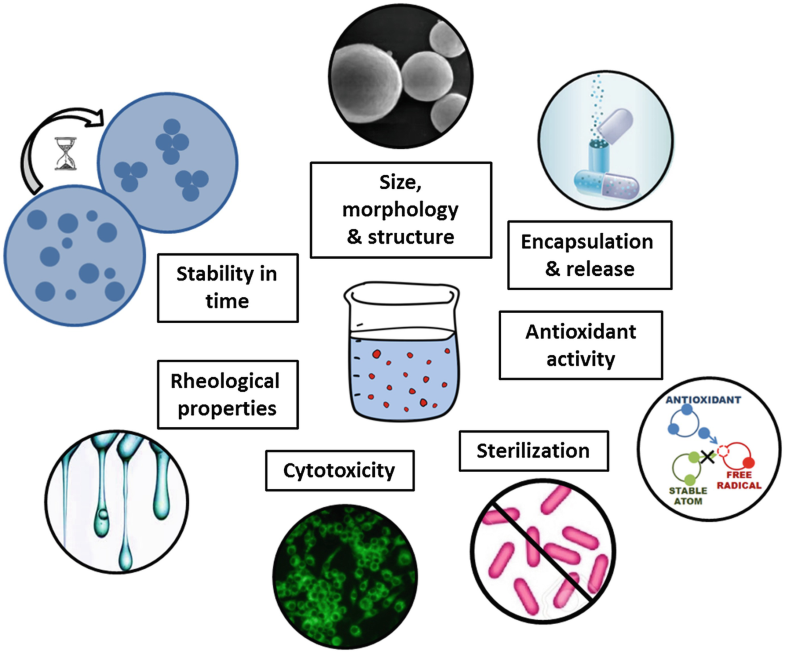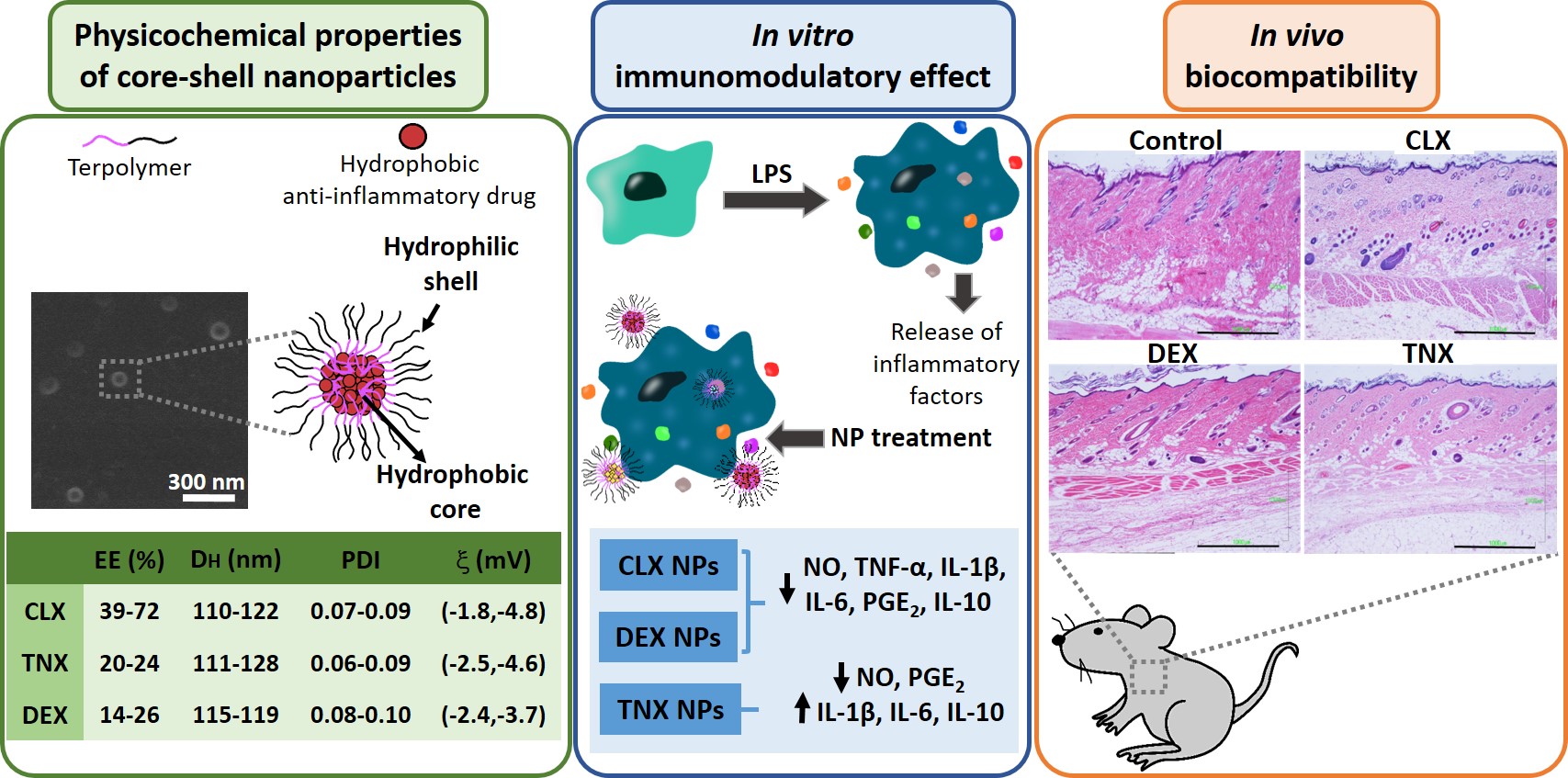Rosmarinic acid is an attractive candidate for skin applications because of its antioxidant, anti-inflammatory, and photoprotective functions, however, its poor bioavailability hampers its therapeutic outcome. In this context, synthesis of polymer conjugates is an alternative to enlarge its applications. This work describes the synthesis of novel water-soluble chitosan – rosmarinic acid conjugates (CSRA) that have great potential for skin applications. Chitosan was functionalized with different contents of rosmarinic acid as confirmed by ATR-FTIR, 1H NMR and UV spectroscopies. CSRA conjugates presented three-fold radical scavenger capacity compared to the free phenolic compound. Films were prepared by solvent-casting procedure and the biological activity of the lixiviates was studied in vitro. Results revealed that lixiviates reduced activation of inflamed macrophages, improved antibacterial capacity against E. coli with respect to native chitosan and free rosmarinic acid, and also attenuated UVB-induced cellular damage and reactive oxygen species production in fibroblasts and keratinocytes.
DEAE-chitosan nanoparticles as a pneumococcus-biomimetic material for the development of antipneumococcal therapeutics
Advanced biomaterials provide an interesting and versatile platform to implement new and more effective strategies to fight bacterial infections. Chitosan is one of these biopolymers and possesses relevant features for biomedical applications. Here we synthesized nanoparticles of chitosan derivatized with diethylaminoethyl groups (ChiDENPs) to emulate the choline residues in the pneumococcal cell wall and act as ligands for choline-binding proteins (CBPs). Firstly, we assessed the ability of diethylaminoethyl (DEAE) to sequester the CBPs present in the bacterial surface, thus promoting chain formation. Secondly, the CBP-binding ability of ChiDENPs was purposed to encapsulate a bio-active molecule, the antimicrobial enzyme Cpl-711 (ChiDENPs-711), with improved stability over non-derivatized chitosan. The enzyme-loaded system released more than 90% of the active enzybiotic in ≈ 2 h, above the usual in vivo half-life of this kind of enzymes. Therefore, ChiDENPs provide a promising platform for the controlled release of CBP-enzybiotics in biological contexts.
Antitumor Activity of Nanoparticles Loaded with PHT-427, a Novel AKT/PDK1 Inhibitor, for the Treatment of Head and Neck Squamous Cell Carcinoma
Currently, new treatments are required to supplement the current standard of care for head and neck squamous cell carcinoma (HNSCC). The phosphatidylinositol3-kinase (PI3K) signaling pathway is commonly altered and activated in HNSCC. PHT-427 is a dual PI3K-mammalian target of the AKT/PDK1 inhibitor; however, to the best of our knowledge, the effect of the PHT-427 inhibitor on HNSCC has not been investigated. This study aims to evaluate the antitumoral effect of PHT-427-loaded polymeric nanoparticles based on α-tocopheryl succinate (α-TOS). The in vitro activity of PHT-427 was tested in hypopharynx carcinoma squamous cells (FaDu) to measure the cell viability, PI3KCA/AKT/PDK1 gene expression, and PI3KCA/AKT/PDK1 levels. Apoptosis, epidermal growth factor receptor (EGFR), and reactive oxygen species (ROS) were also measured. The presence of PHT-427 significantly enhances its antiproliferative and proapoptotic activity by inactivating the PI3K/AKT/PDK1 pathway. Nanoparticles (NPs) effectively suppress AKT/PDK1 expression. Additionally, NPs loaded with PHT-427 produce high oxidative stress levels that induce apoptosis. In conclusion, these results are promising in the use of this nanoformulation as a PHT-427 delivery system for effective HNSCC treatment.
Oregano essential oil micro- and nanoencapsulation with bioactive properties for biotechnological and biomedical applications
Due to the preservative, antioxidant, antimicrobial and therapeutic properties of oregano essential oil, it has received an emerging interest for biotechnological and biomedical applications. However, stability and bioactivity can be compromised by its natural volatile and hydrophobic nature, and by external factors including light, heat or oxygen. Therefore, micro- and nanoencapsulation are being employed to guarantee oregano oil protection from outside aggressions and to maximize its potential. Oregano oil encapsulation is an interesting strategy used to increase its stability, enhance its bioactivity and decrease its volatility. At the same time, the versatility that micro- and nanocarriers offer, allow to prepare tailored systems that can provide a controlled and targeted release of the encapsulated principle, influence its bioactive activities or even provide additional properties. Most common materials used to prepare these carriers are based on lipids and cyclodextrins, due to its hydrophobic nature, polymers due to its versatility in composition and hybrid lipid-polymer systems. In this context, recently developed micro- and nanocarriers encapsulating oregano oil with applications in the biotechnological and biomedical fields will be discussed.
Paclitaxel-loaded polymeric nanoparticles based on α-tocopheryl succinate for the treatment of head and neck squamous cell carcinoma: in vivo murine model
The prognosis of patients with recurrent or metastatic head and neck squamous cell cancer (HNSCC) is generally poor. New treatments are required to supplement the current standard of care. Paclitaxel (PTX), an effective chemotherapeutic for HNSCC, has serious side effects. A polymeric nanocarrier system was developed for the delivery of PTX to improve HNSCC treatment. This study aimed to evaluate the antitumor efficacy of PTX-loaded polymeric nanoparticles based on α-TOS (PTX-NPs) administered by direct intratumoral injection into a Hypopharynx carcinoma squamous cells (FaDu) tumor xenograft mouse model. The nanocarrier system based on block copolymers of polyethylene glycol (PEG) and a methacrylic derivative of α-TOS was synthesized and PTX was loaded into the delivery system. Tumor volume was measured to evaluate the antitumor effect of the PTX-NPs. The relative mechanisms of apoptosis, cell proliferation, growth, angiogenesis, and oxidative and nitrosative stress were detected by Western blotting, fluorescent probes, and immunohistochemical analysis. The antitumor activity results showed that compared to free PTX, PTX-NPs exhibited much higher antitumor efficacy and apoptosis-inducing in a FaDu mouse xenograft model and demonstrated an improved safety profile. Ki-67, EGFR, and angiogenesis markers (Factor VIII, CD31, and CD34) expression were significantly lower in the PTX-NPs group compared with other groups (p < .05). Also, PTX-NPs induced oxidative and nitrosative stress in tumor tissue. Direct administration of PTX-loaded polymeric nanoparticles based on α-Tocopheryl Succinate at the tumor sites, proved to be promising for HNSCC therapy.
Antimicrobials in Dentistry
Dental caries (decay) is caused by pathogenic bacterial species, which afflicts nearly a third of the world’s population from early childhood to old age. Treatment of tooth decay often involves the use of filling materials to restore the cavity; however, if untreated, it can cause pain, infection and eventually lead to tooth loss. Since the oral environment is colonised by many different microorganisms, bacterial biofilms can form on these filling materials, contributing to secondary caries that can eventually lead to the failure of the dental restoration. Thus, preventing the formation of bacterial biofilms is an important strategy in the management of caries, which has led to research enabling antimicrobial capabilities in dental materials. Materials and pharmaceutical sciences are in a continuous race against microbial resistance but are trying to balance between beneficial biota associated with the oral cavity, and, of course, avoiding a harmful effect on tissues is challenging. This has, therefore, stemmed a substantial interest in both preventive and restorative measures that would enable limiting the formation of secondary caries, oral microbial biofilms, and the retention of tooth mineral. Thus, innovative strategies are being explored and here we present a review with a focus on strategies that can inhibit or limit the formation of bacterial biofilms.
Hyaluronic acid (HA)-coated naproxen-nanoparticles selectively target breast cancer stem cells through COX-independent pathways
Cytotoxic chemotherapy continues to be the main therapeutic option for patients with metastatic breast cancer. Several studies have reported a significant association between chronic inflammation, carcinogenesis and the presence of cancer stem cells (CSC). We hypothesized that the use of non-steroidal anti-inflammatory drugs targeted to the CSC population could help reducing tumor progression and dissemination in otherwise hard to treat metastatic breast cancer. Within this study cationic naproxen (NAP)-bearing polymeric nanoparticles (NPs) were obtained by self-assembly and they were coated with hyaluronic acid (HA) via electrostatic interaction. HA-coated and uncoated NAP-bearing NPs with different sizes were produced by changing the ionic strength of the aqueous preparation solutions (i.e. 300 and 350 nm or 100 and 130 nm in diameter, respectively). HA-NPs were fully characterized in terms of physicochemical parameters and biological response in cancer cells, macrophages and endothelial cells. Our results revealed that HA-coating of NPs provided a better control in NAP release and improved their hemocompatibility, while ensuring a strong CSC-targeting in MCF-7 breast cancer cells. Furthermore, the best polymeric NPs formulation significantly (p < 0.001) reduced MCF-7 cells viability when compared to free drug (i.e. 45 ± 6% for S-HA-NPs and 87 ± 10% for free NAP) by p53-dependent induction of apoptosis; and the migration of these cell line was also significantly (p < 0.01) reduced by the nano-formulated NAP (i.e. 76.4% of open wound for S-HA-NPs and 61.6% of open wound for NAP). This increased anti-cancer activity of HA-NAP-NPs might be related to the induction of apoptosis through alterations of the GSK-3β-related COX-independent pathway. Overall, these findings suggest that the HA-NAP-NPs have the potential to improve the treatment of advanced breast cancer by increasing the anti-proliferative effect of NAP within the CSC subpopulation.
Emerging Biofabrication Techniques: A Review on Natural Polymers for Biomedical Applications
Natural polymers have been widely used for biomedical applications in recent decades. They offer the advantages of resembling the extracellular matrix of native tissues and retaining biochemical cues and properties necessary to enhance their biocompatibility, so they usually improve the cellular attachment and behavior and avoid immunological reactions. Moreover, they offer a rapid degradability through natural enzymatic or chemical processes. However, natural polymers present poor mechanical strength, which frequently makes the manipulation processes difficult. Recent advances in biofabrication, 3D printing, microfluidics, and cell-electrospinning allow the manufacturing of complex natural polymer matrixes with biophysical and structural properties similar to those of the extracellular matrix. In addition, these techniques offer the possibility of incorporating different cell lines into the fabrication process, a revolutionary strategy broadly explored in recent years to produce cell-laden scaffolds that can better mimic the properties of functional tissues. In this review, the use of 3D printing, microfluidics, and electrospinning approaches has been extensively investigated for the biofabrication of naturally derived polymer scaffolds with encapsulated cells intended for biomedical applications (e.g., cell therapies, bone and dental grafts, cardiovascular or musculoskeletal tissue regeneration, and wound healing).
Characterization Techniques for Emulsion-Based Antioxidant Carriers with Biomedical Applications
Emulsion-based antioxidant carriers are widely used in the food industry and pharmacology. After designing and synthesizing a determined emulsion-based antioxidant vehicle, it is essential to physicochemically characterize it in order to check if it meets the expected requirements for each application. In this sense, a good understanding of the basis of characterization techniques and methods to evaluate the design and performance of these encapsulation systems is crucial. In this chapter, the main characterization techniques of emulsion-based antioxidant carriers for biomedical applications are presented. A wide variety of techniques used in the evaluation of both continuous and dispersed phases of the emulsion system have been reviewed, from stability, rheology, cytotoxicity or sterilization of the whole emulsion; to the specific study of properties such as morphology, structure or size of the dispersed phase. Special emphasis has been placed on the antioxidant activity of the carriers being the key advantage of these emulsion-based systems.
Modulation of Inflammatory Mediators by Polymeric Nanoparticles Loaded with Anti-Inflammatory Drugs
The first-line treatment of osteoarthritis is based on anti-inflammatory drugs, the most currently used being nonsteroidal anti-inflammatory drugs, selective cyclooxygenase 2 (COX-2) inhibitors and corticoids. Most of them present cytotoxicity and low bioavailabil-ity in physiological conditions, making necessary the administration of high drug con-centrations causing several side effects. The goal of this work was to encapsulate three hydrophobic anti-inflammatory drugs of different natures (celecoxib, tenoxicam and dexamethasone) into core-shell terpolymer nanoparticles with potential applications in osteoarthritis. Nanoparticles presented hydrodynamic diameters between 110 and 130 nm and almost neutral surface charges (between −1 and −5 mV). Encapsulation efficien-cies were highly dependent on the loaded drug and its water solubility, having higher values for celecoxib (39–72%) followed by tenoxicam (20–24%) and dexamethasone (14–26%). Nanoencapsulation reduced celecoxib and dexamethasone cytotoxicity in human articular chondrocytes and murine RAW264.7 macrophages. Moreover, the three loaded systems did not show cytotoxic effects in a wide range of concentrations. Celecoxib and dexamethasone-loaded nanoparticles reduced the release of different inflammatory medi-ators (NO, TNF-α, IL-1β, IL-6, PGE2 and IL-10) by lipopolysaccharide (LPS)-stimulated RAW264.7. Tenoxicam-loaded nanoparticles reduced NO and PGE2 production, although an overexpression of IL-1β, IL-6 and IL-10 was observed. Finally, all nanoparticles proved to be biocompatible in a subcutaneous injection model in rats. These findings suggest that these loaded nanoparticles could be suitable candidates for the treatment of inflammatory processes associated with osteoarthritis due to their demonstrated in vitro activity as reg-ulators of inflammatory mediator production.


